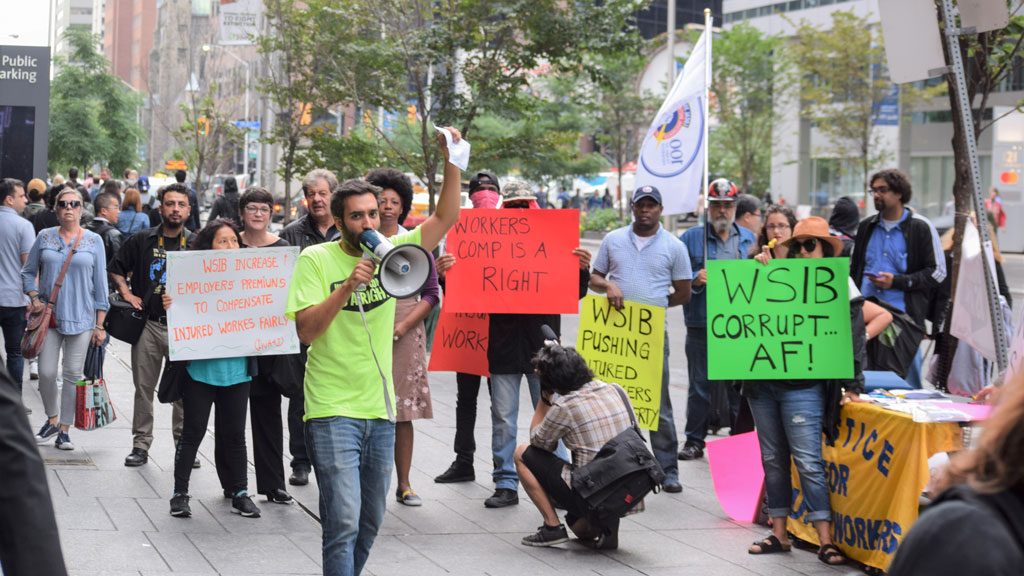Injured workers and labour groups including representatives of the construction trades have criticized Ontario’s Workplace Safety and Insurance Board (WSIB) and construction employers for what they argue are unmerited self-congratulations over the elimination of the WSIB’s unfunded liability (UFL).
The Ontario Federation of Labour (OFL), the Ontario Network of Injured Workers’ Groups (ONIWG) and the Provincial Building and Construction Trades Council of Ontario came out swinging after the WSIB reported on Sept. 26 that the UFL, once $14 billion, had been retired nine years ahead of schedule and that Ontario employers would receive an average premium reduction of 29.8 per cent starting in 2019. Their contention that there were major cuts to benefits were then sharply refuted by the WSIB.
“The WSIB has eliminated its unfunded liability largely at the expense of benefits to injured workers,” said OFL president Chris Buckley in a statement. “Today’s announcement of an additional cut of nearly 30 per cent to employer premiums will further negatively affect injured workers that far too often struggle to access the benefits to which they are entitled.”
“Injured workers have already borne the burden of paying off the WSIB’s manufactured financial crisis,” claimed ONIWG president Willy Noiles in another statement. “Since 2010, compensation benefits provided to injured workers have been slashed by over $2 billion. Almost half of injured workers with a permanent disability are living at or near poverty levels.”
Carmine Tiano, director of occupational health services for the Building Trades, prepared a summary of WSIB issues for the Building Trades board that included a list of cuts to benefits in the past nine years following the enactment of provincial legislation requiring the WSIB to take steps to retire the UFL.
The numbers show it was very clear the benefits went down
— Carmine Tiano
Ontario Building Trades
Tiano said in an interview benefits were significantly slashed through changes introduced by the Mike Harris government in 1997 and the cuts since 2009 further hurt injured workers. The list he compiled showed drug benefits cut by one-third between 2009 and 2014, a reduction in the amount of time permitted for new job searches, ramped-up implementation of the Better at Work policy he said forced workers to return to work before they were ready, and punitive application of pre-existing conditions policies to reduce benefits.
Compensation for non-economic losses was also cut drastically, he said. It was calculated by the OFL that the total value of the benefits reductions was $2.5 billion.
“The numbers show it was very clear the benefits went down,” said Tiano. “And a lot of it was more stringency on entitlements, decreasing medical costs, decreasing permanent impairment, that led to the UFL being paid off 10 years before it had to be.
“(Consultant) Harry Arthurs had put in a plan, slow and steady, by 2027. The WSIB only had to be at 60 per cent funding by 2017, but by 2018 they are at 100 per cent. What does that tell you?”
Tiano calculated construction employers will see their premiums drop by 32 per cent, more than the average.
David Frame, director of government relations for the Ontario General Contractors Association, and Tom Teahen WSIB president and CEO, both denied workers paid an excess price to reduce the UFL.
“This was not done on the back of the injured workers, this was done by employers paying more into the system,” said Frame after the WSIB announcement. “The assessment dollars that have gone out to injured workers continues to go up, entitlements have expanded, we see things like chronic stress added.”
Stakeholders attending the WSIB’s annual meeting in Toronto had to walk past protesting injured workers outside the Marriott hotel where the meeting was held.
Asked about the protesters, Teahen said, “We have been able to eliminate the UFL by focusing more attention on recovery and return to work, and those outcomes have improved significantly over the past eight years and that is only a benefit to the people who are injured. We can help the recovery and help them get back to work sooner, that is important.
“The reduction in premium rates that we announced is associated with our ability to release a component of the premium rate that was solely dedicated to the unfunded liability, it bears no relationship to the benefits we owe to workers for the injuries they have suffered.”
In response to the claims of deep cuts as outlined by the Building Trades, the WSIB later issued a statement denying it has reduced benefits since 2009.
“Between 2009 and 2015, we experienced a 22-per-cent decline in lost-time claims,” wrote spokesperson Rachel dePass.
“This contributed to a significant decline in overall benefits paid during that period. But the average benefits paid per injured person per day has remained the same since 2009 on an inflation-adjusted basis. In fact, average health care spending per person increased over that time period: In 2009 the figure was approximately $1,500 per person. In 2015, it was just under $1,600.
“Not only are we spending more on health care and helping people recover and return to work sooner, we’re also covering more injuries including chronic mental stress, presumptive PTSD and presumptive cancer coverage.”
Tiano suggested the WSIB had not intentionally set out to harm workers but as changes were implemented, the board enthusiastically embraced austerity and it became “cool” to reduce the UFL.
The ONIWG statement called on the WSIB and the Ford government to reverse the $1.45-billion annual “gift” to employers and instead issue restitution to injured workers.
Similarly, Tiano said, “If the government allocated the dividend fairly, it would have used some of the $1.5 billion per year to reverse these austerity measures, restoring the benefits that it and the WSIB reduced.”





Recent Comments
comments for this post are closed